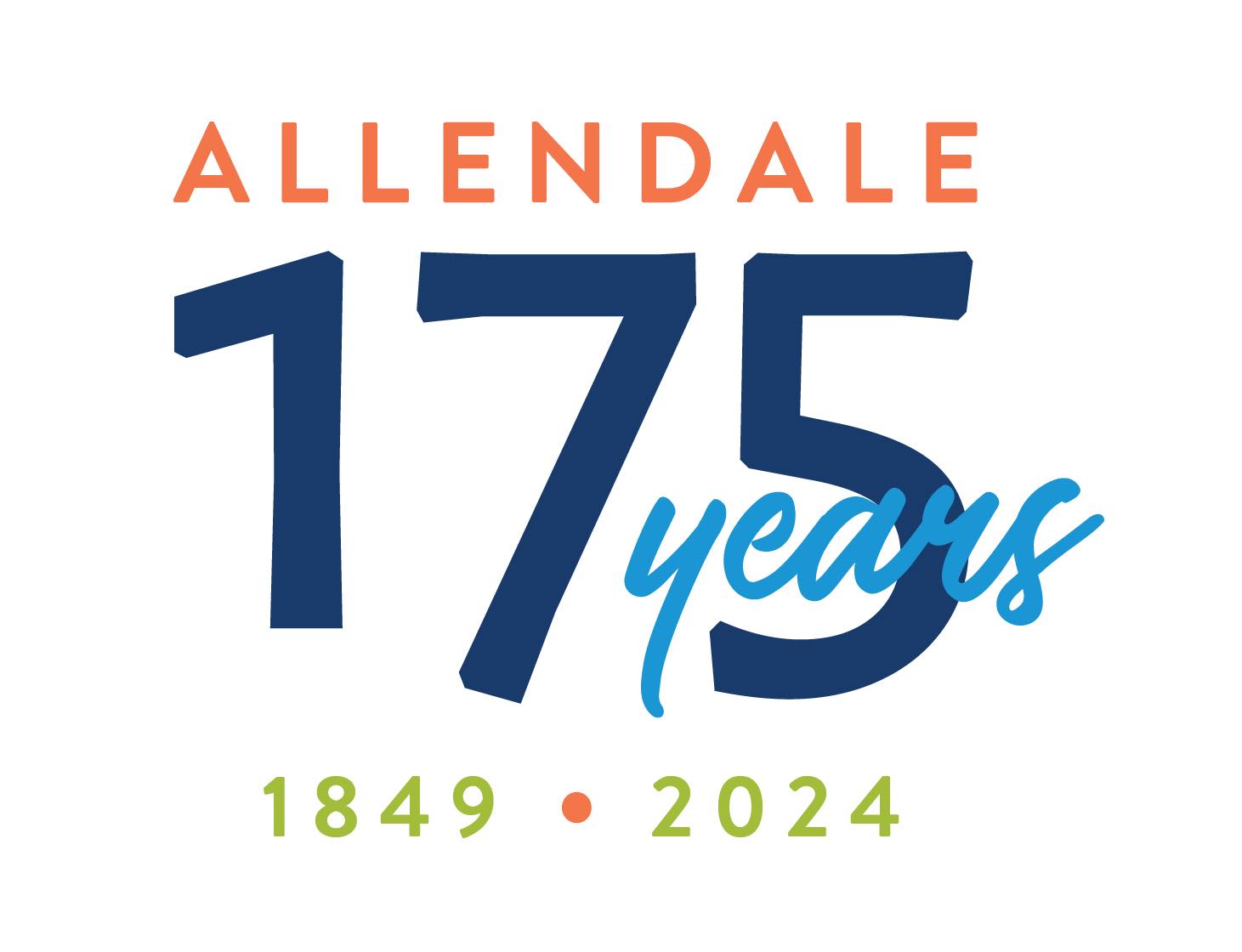-
Allendale's 175th Anniversary - Allendale's History through 1885
Kathy HanesThursday, February 1, 2024
Allendale—Celebrating 175 years in 2024—A 100th anniversary is called a centennial, but what do you call a 175th anniversary? It's a demisemiseptcentennial, of course! And in all honesty, I am grateful for Wikipedia, Google and other search engines that allowed me to look up the answer in record time. It’s a mouthful, but worth noting to memory, as Allendale gears up to celebrate this momentous occurrence throughout all of 2024.
The History of Allendale...how does one sum up 175 years of history for Allendale township in two pages? Simply put; It seems impossible! But, I am going to attempt to give you a little glimpse into the events that have helped to develop our township into what it is today. Several sources were used to obtain these historical facts, including Plat maps, Standard Atlas of that time, county records, a 1973 Allendale History book, written by Fanny Sheridan, the 1998 Allendale Township Historical book and some help from my fellow historians Terry VanDyken and Lorraine Busman. I’m a firm believer in presenting the facts, even though we may not agree with the way things were done in the past. This is how Allendale came to be and why we can celebrate 175 years of being a township. So, sit back and enjoy this little highlight reel of the history of Allendale...
The Formative Years of Allendale Township: 1800 to 1880
Early 1800’s—Long before there were paved roads, schools, stores and homes, this area was rich in natural resources that provided a living for the indigenous population of West Michigan. Michigan became a state in 1837 and later that same year, the newly elected state legislature established and designated the county of Otta-wa. Animal pelts were all the fashion in Europe and out east during this time and the local forests provided hunting opportunities that allowed for fur trading. Waterways to transport these furs gave way to logs, gravel and people as the years passed. Wooded property made this area desirable to settlers looking for a place to call home—isn’t funny how some things never change?
1842—The first permanent settler within the township, Richard Roberts, arrived in the area and settled along the Grand River in the area formerly known as Charleston Landing. Being near the water allowed the little vil-lage to grow and eventually included a store, several homes, a blacksmith shop, sawmill and a spoke factory. There were other prominent areas along the Grand River, and other desirable locations in the region, that were eventually absorbed into what is now Allendale Township:
• Charleston landing—located at the end of 60th Avenue and the Grand River.
• Blendon Landing—located along the river of what is now GVSU.
• Conger—located on 64th Avenue, between Pierce St. and Fillmore, across from what is now Chris-tian Fellowship Assembly. Home of the first official grocery store in Allendale Township.
• Bass River—located where the gravel pits are out by 96th and the Grand River. During the early years, Bass River was much larger than Allendale and could have continued growing, were it not for the a rich gravel deposit discovered under the town. As the demand for gravel grew, residents moved from the area. Homes, stores and other buildings were either relocated, or ended up at the bottom of the gravel pits. Gravel from the pits was moved down river and used in the construction of Chicago buildings and highways. I bet you didn’t know that.
• Pearline—located near 56th Avenue and Lake Michigan Drive.
• Rusk—located in the southwest quadrant of the township, grew up around a sawmill and a general store.
1840 into 1850—This era saw many settlers moving in to the region. Along with Richard Roberts, came others with the surnames of Jones, Pierson, Scott, Balcolm, Hanna, Milne and Reed. These were some of the earliest settlers, in what would become Allendale Township.
1848—Henry Pennoyer, who was a Michigan State Senator, along with other leaders in the area wrote a peti-tion to Lansing to claim the area as Malta Township. Wait, what? Oh, I mean...Allandale, no...AllEndale.
Many of the early settlers were of Scottish descent and wanted to name the beautiful area after the “Rose of Allandale”. Another explanation for the spelling is that Allendale is named after Capt. Hannibal Allen, son of Ethan Allen of Revolutionary War fame. The captain’s widow moved to Eastmanville and bought 100 acres near what later became the County Farm. Since the Allen family had military and political clout, it has been surmised that the township was named after them, thus the change in the spelling.
Winter of 1849—Soon after the first of the year, Allendale is officially designated a township! There has been some back and forth regarding the actual date on record, but thanks to some sleuthing from our local deputy clerk, it was determined that the actual date on record with the state was in fact 1849. The glitch came from submitting the petition in 1848, but not being officially designated until 1849. During this time, a U.S. Post Office, Wesleyan Methodist church, Conger General Store and a Congregational Church established a posi-tion within the township. There were no stand alone business establishments yet. Many of the early settlers built their private homes with a place for ‘business’ to be conducted within. The first census for Allendale Township was taken in 1850 and shows a population of 168. Compare this to an 1840 entire Ottawa County census of 208. Townships with a population under 100 were not registered during this time.
Spring of 1849—Soon after being designated a township, town meetings were held in the home of Richard Roberts. They held an election for township supervisor, clerk, treasurer, Justice of the Peace and Highway Commissioner. Soon after this, it was deemed necessary to establish the first school district. In the spring of 1849, the first public building was built within the township. The Little Red School was built on the east side of old Stagecoach Road, and you can still see the ridge of Stagecoach Road from 68th Avenue as you look to the east (64th Avenue) by what is now the Hovingh farm. Since the Little Red School was the only public building at the time, it was also used as the Town Hall for town meetings, church services for the Wesleyan Methodist congregation and for almost every type of public gathering. As the township grew, the need for more schools increased to serve the families of the area. Eventually, there were 10 one-room schools built throughout the township, with each school being built on land that was donated by local families. When the school was no longer in use, the land reverted back to the property owner. Some of those one-room schools are still standing and in use today as private homes. The most visible one-room schoolhouse still standing is Brotherton school, located on the NW corner of 68th and Pierce. The Christian School was established in 1915, and Grand Valley State College was established in 1961. But we’ll highlight their stories in a later article.
1880 to 1885—As time passed, more families moved to the area, establishing roots and calling Allendale home. While you might recognize some of the early settlers surnames, there was a surge of newcomers during this time that still have many descendants in the area. Tell me you don’t know somebody with this last name: Alderink, Berens, Bouwer, Broene, Harmsen, Hinken, Jeurink, Klomparens, Knoper, Kraker, Lemmen, Mohr, Potgeter, Sall, Veldink, Veldhuis, Walcott or Wolbrink. The years have passed and there are so many more who have moved to the area and now call Allendale home, but space is just too limited to tell you all about them in one article.
We hope you enjoyed this little glimpse into the past and that we can appreciate the founders of our community. We thank those who had the vision and foresight over 175 years ago to establish this area that we can call home. Here, Now, In Allendale.
Tell a Friend
-
-
-
Welcome New Members!
-
-
-
-


-slider.png)
.png)
-2.png)



